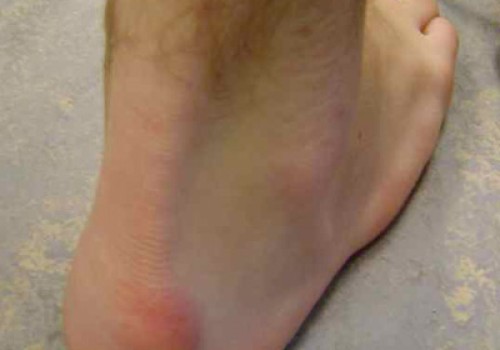Haglund’s deformity is a bony enlargement of the back of the heel.
This most often leads to painful bursitis. Bursitis is an inflammation of the bursa (fluid filled sac between the tendon and bone). The soft tissue near the Achilles tendon becomes irritated and inflamed when the bony enlargement rubs against shoes. It is the inflamed bursa that produces the redness and swelling associated with Haglund’s deformity. Haglund’s deformity is often called “pump bump” because the rigid backs of pump-style shoes can create pressure that aggravates the enlargement when walking. In fact, the deformity is most common in young women who wear pumps.
To some extent, heredity plays a role in Haglund’s deformity. People can inherit a type of foot structure, for example, high arches, which makes them prone to developing this condition. The heel bone is tilted backward into the Achilles tendon, causing the uppermost portion of the back of the heel bone to rub against the tendon.
A tight Achilles tendon can also play a role in Haglund’s deformity, causing pain by compressing the tender and inflamed bursa. In contrast, a tendon that is more flexible results in less pressure against the painful bursa.
Pump Bump
Another possible contributor to Haglund’s deformity is a tendency to walk on the outside of the heel. This tendency, which produces wear on the outer edge of the sole of the shoe, causes the heel to rotate inward, resulting in a grinding of the heel bone against the tendon. The tendon protects itself by forming a bursa, which eventually becomes inflamed and tender.
A noticeable bump on the back of the heel, swelling, pain and redness, near the inflamed tissues are symptoms of Haglund’s deformity.
Treatment: Non-surgical Approaches
The non surgical-treatments of Haglund’s deformity are aimed at reducing the inflammation of the bursa and eliminating pain. While these approaches can resolve the bursitis, they will not shrink the bony protrusion.
- Orthotic devices
- Medication
- Ice
- Exercises
- Heel lifts
- Heel pads
- Shoe modification
If non-surgical treatment fails to provide adequate pain relief, surgery may be needed. Dr. Hausen will evaluate your condition, carefully examine your x-rays and select a plan tailored to your needs.

